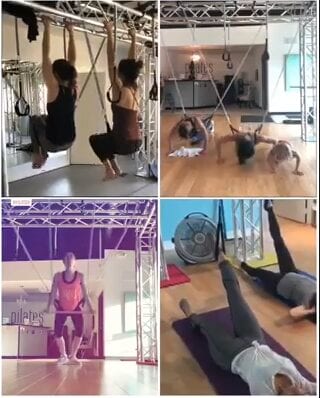
I wanted to post this now to help us re-calibrate our new normal and begin to think ahead to spring and good health. Many of us, myself included, have felt the impact of COVID-19 in some way or the other. My goal is to reset, revise and re-energize what is ahead. How about you?
Please think about the hurdles you have overcome and read about Jill’s journey and her ability to reset, revise and re-energize her life and her business. You will be amazed.
Everything can be taken from a man but one thing: the last of the human freedoms—to choose one’s attitude in any given set of circumstances, to choose one’s own way. – Vikter Frankl, Holocaust survivor
How I met Jill
I had to opportunity to meet Jill Harris in 2019 and try for myself the power of a new concept in fitness equipment called FitSprings. As a runner and functional fitness trainer, this was the perfect piece of equipment for me and my clients. I have worked with a variety of training equipment through the years. I have used and still use free weights, bands, kettle bells, TRX suspension system, yoga and Pilates poses, functional trainers, etc.
In my opinion, FitSprings could not be a better solution for people with injuries, functional weaknesses (meaning it is difficult to do many of the activities of daily life) or stability issues. My demographic – people turning 60 and beyond take note!
It is also the perfect piece of equipment for elite athletes and dancers.
The genesis of an idea
I just had to ask Jill about the genesis of FitSprings. You will be inspired to be stronger both physically and mentally, I guarantee it – I was inspired.
This post is also great for those who are starting a business or changing careers as well. It is a refreshing story about struggles and successes. We can learn something from these lessons that can help us now. Below is my Q&A with Jill.
How did you get the idea for FitSprings
I wanted to prevent injuries and pain as well as find a way to develop optimal form and protecting joints
There were two recurring themes that brought FitSprings to life.
- The first was clients complaining about injuring their lower backs and hips during group fitness classes and were asking for ways to minimize these injuries.
- I wanted to create a system that could help correct bad form and take pressure off the joints that were overworking during their workouts.
Creating standing exercises and cardio routines
- My second motive for creating these workouts was to address how few standing exercises and cardio routines are used in regular Pilates training sessions. My third motive was to keep clients in my studio rather than them shopping around to get everything they needed that I wasn’t currently providing.
How did you get the idea for what it should be and how did you actually get it built?

When I initially had the idea for what it was going to look like my first thought was it needed to be Hexagons from overhead. I asked everyone I knew for months if they knew someone who could build what I wanted and finally I found a metal worker who built structures for burning man.
In his one man shop he created a structure with hexagons that fit into two beams in my studio. There were several points with eye bolts so I could attach whatever I wanted to into it. In the beginning I had no idea if it was going to be springs, bands or bungees.
Version 2.0
The first structure fit 3 people in the front line and 2 in the back line but it was a little tight on one side for everyone. A ballet dancer suggested I get a 2 person portable one made so I could take it places with me and that was version 2.0.
It had legs and was slightly wider front to back and could also be dismantled with allen wrenches. It was easy to move around, yet I never took it out of the studio.
I needed to develop something that could be built and sold.
I had created classes with dancers, personal trainers and a physical therapist and had been written up in many newsletters and blogs. People wanted to buy what was then called Informed Technique, but it wasn’t yet ready for sale as I was using parts from Balanced Body and needed to have my own made. A client introduced me to an industrial designer who allegedly would be able to design and help me produce a product that could go to market.
Learning from failure

Because I was running a studio, training my clients and was completely inexperienced at developing a product, I hired the person and paid a retainer fee. He promised me something and never delivered. After spending close to $60,000 for his “design” time I ended up with nothing viable and a drawing of a structure that turned out to be not safe to produce – no springs, straps, bars or handles.
Version 3.0 Is Built
I went back to the original metal worker who at this point was angry I didn’t use him so I hired an architect friend to intervene and try to help with the design. 3.0 was anchored into a wall, had one leg and the cross bar at the leg had hooks to hold all the accessories. At this point I sold 1 and had to figure out a shipping solution because it was a huge frame and parts and again I had no idea.
Things get even more difficult
During this time, I was not well and couldn’t figure out what was happening with me and finally found out I was completely depleted of B12 and had a tumor on one ovary and a fibroid that was pushing into my organs. I also was having a very difficult time dealing with my landlords in my studio space and was starting to look into exit strategies. Everything came to a halt when my doctor said stop everything now and get a hysterectomy.
I closed the studio and 2 days before surgery found a tiny space for my Pilates studio, but was still looking for a place to install the springs. Everywhere I went they didn’t want the legs on the floor and I spent a lot of time and money looking into ways to suspend the structures from the ceiling. In order to do this safely I needed engineers and building codes and so many other things that would have made the cost astronomical.
Rather than give up, I went back to the drawing board and googled Truss manufacturers. Of the many people I contacted, Summer (the current fabricator of FitSprings) was the one person who said she had an idea about how we could make this work. I flew to LA and went to her warehouse and we began to build and piece together what is now the FitSprings.
What is special and different about FitSprings from other fitness equipment?
By adding the circles to the top of a truss that is typically used for aerial and other suspension methods we are able to create the proper spacing needed to recreate the original hexagon points. If you look at a standard A Frame truss which TRX uses, the planes are parallel and wouldn’t work to do arms and legs at the same time – you could recreate one or the other but not both at the same time and have the same results as you do with FitSprings.
This compact structure is versatile whereas an A Frame isn’t. We are able to add springs to every side if we want to. We can add 6 TRX to a standard structure. We can add 2 aerial hammocks and even Redcord (used for physical therapy and sports rehabilitation) or any other suspension system safely.

Who is the ideal client that should consider using FitSprings
With FitSprings you get all the benefits of Pilates (flexibility training, balance, spring resistance, core) as well as the ability to meet the challenge of traditional fitness (cardio, resistance training, push-ups, burpees) without the impact. And its more joint friendly. Clients can get the results they want without joint pain. This can be applied to many populations.
For example:
- Full push-ups without sore wrists and shoulders.
- Cardio and plyometric movements, such as burpees, jumping jacks, and box jumps with less impact to the knees and ankles.
- Core workouts that actually target and challenge your core and don’t hurt your back.
It can also be used in a rehabilitative setting.

In fact, Jill was her own ideal client. One evening, walking down the street she was mugged and attacked at gunpoint. She was severely injured to both her head and back.
She was able to use FitSprings in her rehabilitation because she was unable to lie down, use her arms and other things that traditional training offered. It taught her so much about how really special her FitSprings was. Fortunately, Jill is doing great today, in part due to FitSprings.
Here are a few other examples.
- Athletes who are returning after an injury can use FitSprings to rebuild their conditioning and motor patterning with less impact, so they’re ready to return to the field faster.
- Dancers who are recovering from a knee or ankle strain. FitSprings can help them improve their technique with less impact and overuse.
- Older clients who are at a risk of falling. FitSprings can be used for proprioceptive and balance training, while maintaining an environment of safety.
- FitSprings can be used to progressively and intelligently reintroduce load to the wrists and shoulders after an upper body strain or injury.
How can you find FitSprings near you?
Now that you know a little more about Jill and FitSprings, I hope you are inspired by her story of resilience. I have a FitSprings in my studio in Murrieta, CA. If you are close by and want to train with me, contact me at Turning60andBeyond@gmail.com
You can find others studios that have FitSprings by contacting Jill Harris at www.fitsprings.com
To See FitSprings in Action check out this YouTube video.
